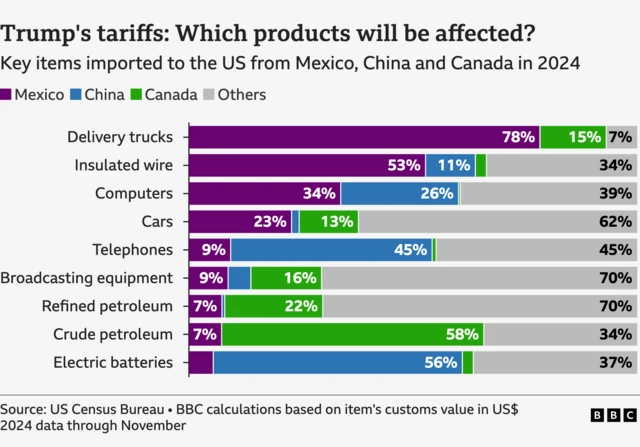Leading up to the 2024 election, Donald Trump had promised to impose tariffs on certain U.S. trading partners and since he has taken office, he has upheld his promise. Tariffs are taxes on imported goods from foreign countries. They are used to protect domestic industries by encouraging manufacturers to produce within the country, offset trade deficits, retaliate against unfair trade practices, punish other countries, and increase revenue for the government. Trump intends to punish Canada, Mexico, and China because he claims they are failing to limit the amount of illegal immigrants and dangerous fentanyl from crossing United States borders. He also intends to reduce the U.S. trade deficit and strengthen American industry by placing tariffs on the three listed countries as well as other unspecified ones.
Who and What Do Tariffs Affect?
It is a commonly known fact that tariffs are taxes on imported goods, but who actually pays the tax tends to be more convoluted. The direct taxpayer is the importing businesses, or the businesses of the country placing the tariff. In the current situation, that would be the United States. Since one of the purposes of tariffs is to protect American industry, it entices companies to produce within the country opposed to going elsewhere since external products are now more expensive. Another one of its purposes is to punish the country the tariff is being placed on, but how are they being affected if they aren’t directly paying the tax? By increasing the prices needed to import their goods into the U.S., the demand for their product and their competitiveness in the market in that area decreases, forcing them to decrease their prices to remain a viable competitor, but plummeting their sales overall. This is on a larger government and corporate scale, however, this all trickles down to the consumers. Importing businesses, in order to maintain their profit margins are going to increase consumer prices. Exporting countries, in this context Canada, Mexico, China, and the European Union, in retaliation to tariffs being placed on them will enforce tariffs of their own, reversing the process and hiking up the prices of goods for their citizens. This will all likely lead to a trade that would collectively sky rocket consumer prices and harm diplomatic and economic relations.
In the United States specifically, what products are expected to be more expensive for consumers? Grocery store items are bound to go up. This would include, but not limited to, most produce, animal products, alcohol, and Canada’s famous maple syrup. Additionally, it would affect the housing market since lumber is mainly imported. On top of that, metals like steel and aluminum would be affected and energy and electricity bills are very likely to go up. Furthermore, it would also affect the electronic and car industries due to the fact that both the supplies needed to manufacture and the manufacturing itself is not all done in the United States. Additionally and ironically, tariffs would actually increase gas prices, even though that was a key selling point in Trump’s campaigning. Unfortunately, these are only some of the products that could be affected by tariffs. Since Trump has taken office, prices have gone up and stocks have plummeted. According to one of the United State’s largest banks, the US Bank, stock values have gone down by 10 percent from peak levels, sparking concern in investors(U.S. Bank, 2025). An article from the renowned academic institution, North Carolina State, states, “Only about one-third of economists are predicting a recession in 2025. But, what more economists do agree on — by a rate of over 50% — is that the economy will grow more slowly in 2025”(CALS News, 2025). Despite this, a CNN source shows that Trump thinks it will be “worth it” in the long run even if a recession is to occur(CNN, 2025). While a recession is not entirely unlikely, Trump’s tariffs, without a doubt, will result in national economic decline.
Timeline
In the small amount of time Trump has been in office, his tariff battle has been very eventful and complicated to follow, so this is a timeline to better understand the course of events. On February 1st, Trump placed a 25 percent tariff on all goods from Mexico and Canada and a 10 percent tariff on Chinese goods. Even though he promised during his campaigning that he would bring down consumer prices for the American people, he is aware tariffs might have harmful effects proven by his tweet on February 2nd that wrote, “WILL THERE BE SOME PAIN? YES, MAYBE (AND MAYBE NOT!).” Two days after he imposed the tariffs, he placed a 30 day pause on the Canadian and Mexican tariffs following backlash, but he also threatened tariffs on the European Union at the same time. On February 4th, China’s 10 percent tariff went into effect, causing China to retaliate with their own tariff on liquefied natural gas and coal. About a week later, he reintroduced a 25 percent tariff from his first term on all steel and aluminum. On Valentine’s Day, he made the statement that tariffs on foreign cars will go into effect on April 2nd, but not on April 1st because he is “a little superstitious.” On February 27th, he claimed tariffs on Canada and Mexico, as well as an additional 10 percent on China, will go into effect on March 4th, and on that date, they were enacted. In response, Canadian Prime Minister, Justin Trudeu, responded with 25 percent tariffs on 155 billion dollars worth of American goods. The following day, Trump paused the car tariffs after backlash from several car companies, including Ford and General Motors. That same day, Mexican president, Claudia Sheinbaum, threatened to enact retaliatory measures on March 9th if Trump persisted. On March 6th, he once again suspended tariffs on Canada and Mexico. However, he claims he still has the intention of putting into effect a tariff on steel and aluminium on March 12th and on April 2nd, tariffs on all U.S. trading partners. On March 10th, China imposed tariffs on farming goods, such as chicken and corn, and Ontario, Canada placed a tariff on electricity going to New York, Michigan, and Minnesota. Trump, feeling attacked by the electricity surcharge, threatened to double Canadian metal tariffs, but both sides backed down. However, the next day Canada and the European Union announced retaliatory tariffs worth billions of dollars on U.S. goods, but are holding back until April 1st in an attempt to negotiate. Trump, nonetheless, has no intentions of negotiations, for he brought up his largest tariff, at 200 percent on European alcoholic beverages. Even though those are all the major events as of now, Trump will continue to pursue his tariff agenda and one can only wait and watch to see if these tariffs will actually go into effect and the effects they leave on the globe’s trade market and economy.
References
Cerullo, M. (2025, March 6). Trump’s tariffs on Canada, Mexico and China are in effect. Here’s what could get pricier — and when. CBS. https://www.cbsnews.com/news/trump-tariffs-what-will-cost-more-inflation/
Chen, J. (2025, January 31). Trade Wars: History, Pros & Cons, and U.S.-China Example. Investopedia. Retrieved March 24, 2025, from https://www.investopedia.com/terms/t/trade-war.asp
Durante, A. (2025, February 19). Who Pays Tariffs? Americans Will Bear the Costs of the Next Trade War. Tax Foundation. Retrieved March 24, 2025, from https://taxfoundation.org/blog/who-pays-tariffs/
Fact Sheet: President Donald J. Trump Imposes Tariffs on Imports from Canada, Mexico and China. (2025, February 1). The White House. Retrieved March 24, 2025, from https://www.whitehouse.gov/fact-sheets/2025/02/fact-sheet-president-donald-j-trump-imposes-tariffs-on-imports-from-canada-mexico-and-china/
Minsberg, T. (2025, March 13). A Timeline of Trump’s On-Again, Off-Again Tariffs. New York Times. https://www.nytimes.com/2025/03/13/business/economy/trump-tariff-timeline.html
Race, M. (2025, March 12). Six things that could get more expensive for Americans under Trump tariffs. BBC. https://www.bbc.com/news/articles/cvgpvq20qmdo
Siripurapu, A. (2025, February 3). What are Tariffs. Council of Foreign Relations. Retrieved March 24, 2025, from https://www.cfr.org/backgrounder/what-are-tariffs
Swanson, A., & Buckley, C. (2025, February 4). China Counters Trump’s Tariffs As Talks Remain in Limbo. New York Times. https://www.nytimes.com/2025/02/04/business/economy/trump-tariffs-china.html
Walace, A. (2025, March 21). Trump seems to think America needs a recession. Some people are still recovering from the last one. CNN. https://www.cnn.com/2025/03/21/economy/recession-negative-outcomes-long-lasting/index.html
Walden, M. (2025, March 21). Why Are Recession Fears Back? CALS News. https://cals.ncsu.edu/news/you-decide-why-are-recession-fears-back/#:~:text=Thus%20far%2C%20polls%20of%20economists,grow%20more%20slowly%20in%202025.
Wu, J. (2025, March 15). Where Trump’s tariffs will hit your grocery list, from avocados to frozen fish. NBC. https://www.nbcnews.com/business/personal-finance/trumps-tariffs-will-hit-grocery-list-avocados-frozen-fish-rcna194770

